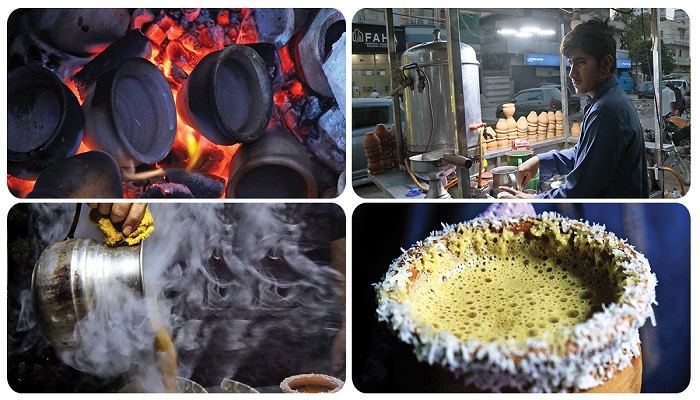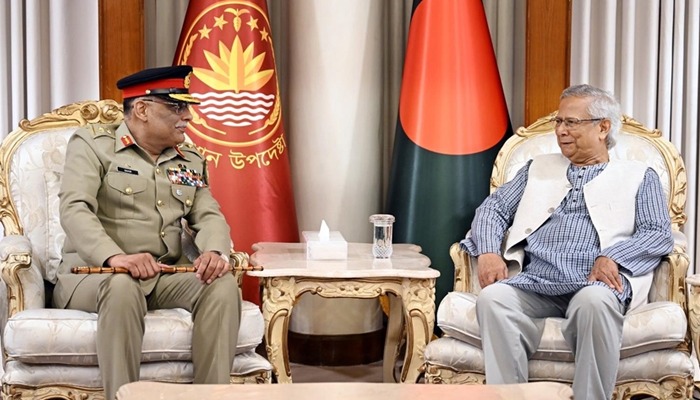KARACHI: Tandoori roti and tandoori chicken are household foods in South Asian society. Now, tandoori chai (tea from clay oven) has become the latest craze among food lovers in the city.
Served in terracotta mugs, still hot from the traditional oven, Karachi’s newest addition to the list of teas is not only unique in name but also otherwise.
Its ingredients include exclusive tea leaves, milk, cinnamon and cardamom powder. To sweeten the tea, condensed milk is used. However, the icing on the cake is the addition of saffron to give the tea a special kind of flavour.
The tea-making process is unusual. After making the tea, the specialists put the beverage in a hot clay pot which is baked at high temperatures in a tannour, colloquially known as the tandoor (clay oven). This allows the moisture that has saturated the clay to slowly turn into steam. The hot clay pot then provides a pleasant smell like earthenware and infuses ‘tandoor flavour’ in the tea.
This is processed at a high temperature which makes it smoky. Finally, the tandoori chai is served in another clay pot. But before pouring the tea in terracotta mugs, the rim of the mug is dipped in coconut powder just to garnish each serving.
A cup of tandoori tea costs Rs90, but in this age of high prices, it is still a relatively cheaper beverage that is attracting people. Either it is the taste of tandoori tea or the magic of the maker’s hand.
Qaiser, the owner of a tea shop, started this business around four years ago in North Nazimabad. In a short span of time, he has managed to attract a good number of customers. For the popularity of the tandoori tea, the tea specialist gives credit to the changing trends in the digital era, saying television channels and the social media platform YouTube inspired him to try his hand at this tea-making business.
He claimed that he’s the pioneer in this field and it was his interest in surfing the internet that he discovered the recipe. “I started making it at home. It has a lovely, rustic and smoky flavour to it which really inspired me to make the product.” The best part of the tea variant is the fact that ingredients like cinnamon and cardamom powder have a number of health benefits. Moreover, the use of saffron makes the tea even healthier.
Instead of loose milk, hygienic tetrapack milk is used in the making of this tea. The best part, according to Qaiser, is the fact that the clay is never reused. This is probably the only drink in which the customer breaks the mug after he finishes the tea. Since the tea is served in disposable mugs, even if the customer orders for the second time, the tea is served in a fresh mug, he said.
He opens the shop daily at 8pm and closes at 2am. He also serves a special kind of Kashmiri tea that contains dried fruit and has a unique pink colour. The tea costs Rs150 per cup. But since a large number of other tea shops in various localities of the city are serving Kashmiri Chai, Qaiser is concentrating more on the tandoori tea. “I am happy as I have customers coming all the way from the Defence Housing Authority and Clifton areas as well”.
A taste for tea
In Karachi, where the classic doodh patti — the thick, strong, and generously sweet tea — dominates all strata of society, the particular alchemy of tandoori chai seduces patrons intrigued by its traditional roots and distinct earthy taste. Moreover, researchers have found that drinking tea lowers the level of stress hormone cortisol, and evidence of long-term health benefits is emerging too. Drinking at least about half a cup of green tea a day reduces the risk of developing depression and dementia, it is said.
While coffee culture has caught on in Pakistan’s main cities with big-name chains and local cafes, it is chai — regardless of how it is prepared — that is nonetheless an essential component of the daily menu.
The country is one of the top tea consumers globally, according to research firm Euromonitor International, while a recent study by Gallup found 73 per cent of Pakistani tea drinkers have at least two or more cups a day. A frequent visitor to one of the most popular tandoori tea stalls in the city told Bol News that “Visiting this tea stall in the open air with my friends is always fun and we all enjoy the tandoori chai here along with gossip”.
He further said, “I can’t resist the aroma of the flavoured chai while passing through this place”.
The tandoori chai presented in a traditional clay cup has revived the typical village life especially when it is poured into an earthen cup which gives it a touch of the village’s soil. Perhaps our urge for the clay-pot tea reflects our strong bond with the old clay utensils.
Even cooking food in clay utensils is again in vogue these days and many people keep clay pipkins (or handi) at their homes to cook and get a desi (local) taste of the food.
Recent research has revealed that cooking in a clay pot is much better than cooking in a normal utensil not just for its various health benefits but also because it makes cooking much simpler. Moreover, it improves the quality of the food at the end. The porosity and natural insulation properties of clay causes heat and moisture to circulate through the clay pots.



















